Das Kehlsteinhaus - "The
Eagle's Nest"
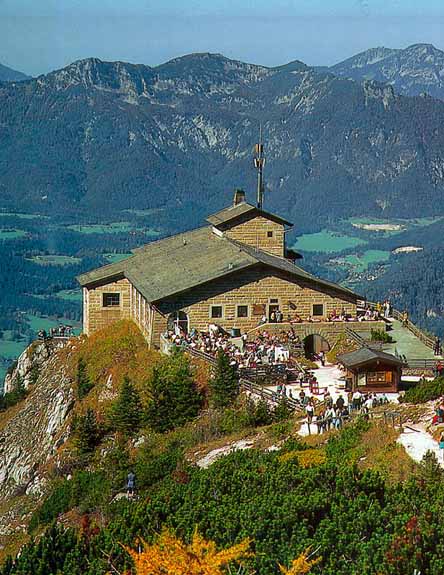
Hitler's Tea House,
known to Americans as "the Eagle's Nest"
Das Kehlsteinhaus is the famous Teehaus
(Teahouse in English) which was built on the Kehlstein mountain
in the Bavarian Alps by the Nazis as a gift to Adolph Hitler
for his 50ieth birthday. Construction was completed by September
1938, seven months before the building was officially presented
to Hitler as a birthday gift on April 20, 1939 by the Nazi party.
Widely known to Americans as The Eagle's Nest, the house is one
of Germany's top tourist attractions and can be reached by a
Tour bus from Munich.
The old photo above shows the east side
of the Eagle's Nest with the patio that was added in the 1960ies
in the foreground. Taken in late Spring, the photo shows the
yellow flowers of a sweet broom bush in bloom in the foreground.
The tower in the center of the building is the Windenstube (Winch
chamber) which houses the engine and the winch for the wire rope
that lifts the elevator from the parking lot up to the building.
Jutting out on the left side in the photo
above is the Eva Brown room. Glassed-in colonnades, with an arched
window at the end, run across the left side of the building.
The colonnades can be accessed through the Eva Braun room. The
two windows in the front, on the left side, are the kitchen windows.
The window on the right in the photo above is a window into the
room that was formerly used as a day room by Hitler's guards.
The door in the center on the east side
opens into a hallway which has a door into the kitchen and a
door into the room used by Hitler's guards. To the left of the
door is the sign that is shown in the photo below which tells
visitors that the building is 1834 meters above sea level.
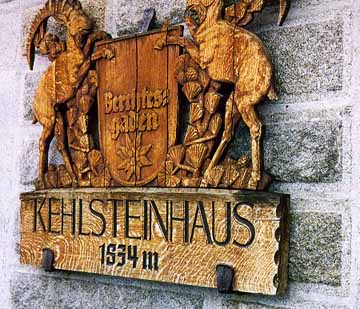 Sign on east side of
das Kehlsteinhaus, 1997
Sign on east side of
das Kehlsteinhaus, 1997
The photo below shows the patio as it
looked when I visited in May 2007. Behind the camera is the path
up to the summit of Kehlstein mountain where there is a large
Christian cross.
 The terrace at the
Eagle's Nest, May 2007
The terrace at the
Eagle's Nest, May 2007
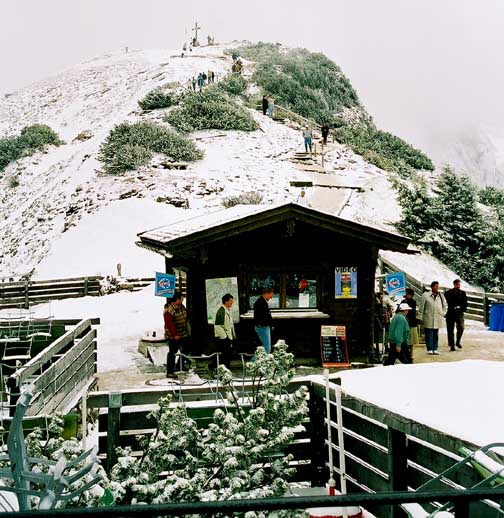 Small store near patio,
Kehlstein summit in background, May 1997
Small store near patio,
Kehlstein summit in background, May 1997
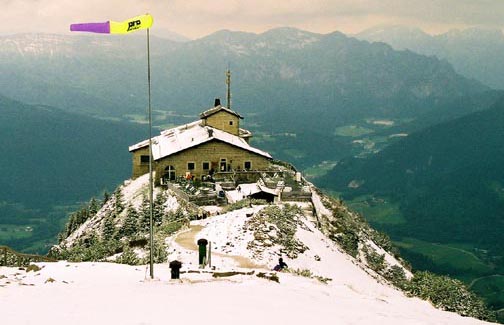 View of Eagle's Nest
taken from the summit, May 1997
View of Eagle's Nest
taken from the summit, May 1997
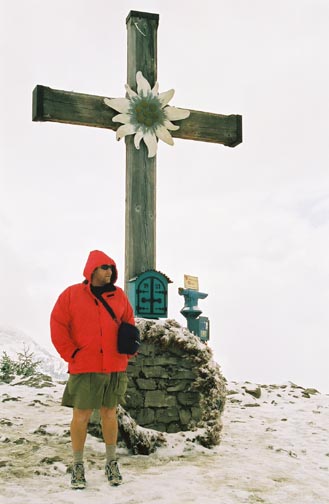 The summit of the Kehlstein,
May 1997
The summit of the Kehlstein,
May 1997
Many Americans mistakenly believe that
the term "Eagle's Nest" refers to Hitler's former private
residence on the Obersalzberg, which was located just below the
Kehlsteinhaus. The movie "War and Remembrance" showed
scenes of events which actually happened at Hitler's residence,
the Berghof, but were filmed at the Kehlsteinhaus. The term "Eagle's
Nest" was allegedly coined by a group of World War I veterans
who visited it at Hitler's invitation, and the name has always
referred only to Hitler's Teehaus.
Hitler made 14 official visits to the
Kehlsteinhaus including his first visit on September 16, 1938,
the day after he had met with British Prime Minister Neville
Chamberlain at his Berghof house on the Obersalzberg in the famous
"appeasement" conference which many historians consider
to be the beginning of World War II. His last official visit
was on October 17, 1940. Hitler also made at least 3 unofficial
visits. His fear of heights caused him to avoid visiting this
fabulous mountain retreat more frequently, but it was a favorite
hangout for his mistress, Eva Braun, who often went there with
her friends.
On April 25, 1945, 318 British Lancaster
bombers conducted two attacks on the area. The homes on the Obersalzberg
belonging to Martin Bormann, deputy chief of staff, and Herman
Goering, were destroyed, along with Hitler's residence, but fortunately
the bombs completely missed the Eagle's Nest. No one was killed
in the bombing because none of the Nazi leaders were there and
all the servants went into an underground bunker on the Obersalzberg,
which is still open to visitors.
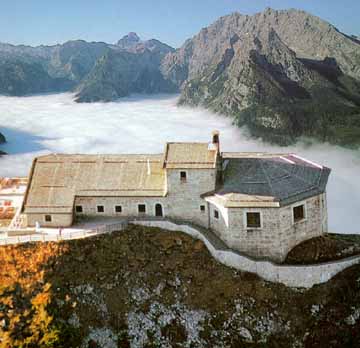
View of das Kehlsteinhaus
from north side
Das Kehlsteinhaus was designed by architect
Roderich Fick as a wooden frame structure, but it consists of
80% concrete, particularly in the area of the octagonal main
hall or reception room, shown to the right in this photo. The
outside walls, as well as the interior walls, are covered by
a facade of granite stones, which gives the impression that the
building is a solid stone structure. The granite stones came
from a quarry near Passau.
 North side of das Kehlsteinhaus,
May 1997
North side of das Kehlsteinhaus,
May 1997
Many levels of foundations had to be
constructed in the building of das Kehlsteinhaus, as shown in
this view taken on the northeast side. The archway over the northeast
entrance was designed to be asymmetrical.
Door handles, instead of knobs, were
typically used in Germany, and door knobs were virtually unknown
on German buildings when das Kehlsteinhaus was built in 1938.
Homesick American soldiers in Germany in the 1940ies and 1950ies
would refer to the USA as "the land of the round doorknob."
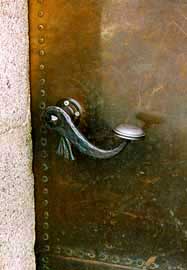 Door handle at Kehlsteinhaus,
1997
Door handle at Kehlsteinhaus,
1997
|